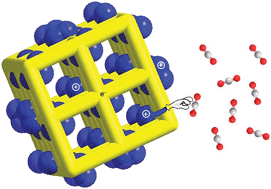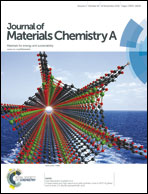Selective adsorption of CO2/CH4 and CO2/N2 within a charged metal–organic framework†
Abstract
Presented here is a new ultramicroporous metal–organic framework (MOF) formulated as [Zn3L2(HCOO)1.5][(CH3)2NH2]1.5·xDMF, 1 (H3L = 9-(4-carboxy-phenyl)-9H-carbazole-3,6-dicarboxylic acid), DMF = N,N-dimethylformamide, consisting of an anionic framework and two types of interlaced one-dimensional channels with 0.42 and 0.79 nm diameters respectively, in which the larger channels accommodate protonated dimethylamine as the counter cations. Gas sorption analysis of N2, CO2 and CH4 was investigated and the isotherms exhibit reversible thermodynamic behaviours without hysteresis desorption, evidencing framework rigidity and permanent porosity of solvent-free 1. The synergistic effect of the open ultramicropores and dimethylamine cations may lead to high efficiency separation of CO2 from CH4 and N2. According to the Toth model, the selectivity of CO2/CH4 and CO2/N2 was calculated to be 96 and 37, respectively. This effort will give rise to a new conception to tailor the charged MOF for high efficiency CO2 adsorption and separation.


 Please wait while we load your content...
Please wait while we load your content...